A typical residential boiler room ranges from approximately 35 square feet (3 square meters) to 55 square feet (5 square meters), accommodating essential heating equipment and service access. Commercial boiler rooms require a ceiling height of at least 8 feet (2.5 meters) for regulatory compliance. Average residential boiler rooms measure approximately 55 square feet (5 square meters) to 90 square feet (8 square meters). The primary purpose of a boiler room is to house boiler heating systems for centralized operation and safety. It contains crucial safety equipment, isolates noise from living areas, and consolidates inspection and repair processes. The normal ceiling height in boiler rooms is approximately 30 square feet (2.5 meters) to 35 square feet (3 square meters). Standard colors for boiler rooms include gray, white, blue, green, yellow, red, and beige, each serving practical or safety-related purposes. Boiler room functionality is enhanced through fire protection, ventilation, well-maintained mechanical equipment, and regular professional inspections. Renovating a boiler room costs between $4,000 (€3,600, £3,000) and $10,000 (€9,000, £7,600) on average. An architect’s involvement in boiler room renovation is not mandatory but highly recommended for optimizing space, ventilation, safety, material selection, energy efficiency, and regulatory compliance. Homeowners face challenges in adhering to safety standards, balancing functionality with aesthetics, selecting appropriate materials, optimizing space, managing ventilation, and navigating the technical complexities of boiler room redecoration.
What is the typical size of a boiler room?
A typical residential boiler room ranges from approximately 35 square feet (3 square meters) to 55 square feet (5 square meters). This allows fitting essential boiler heating equipment with clearance for service access without feeling cramped. For equipment regulations, commercial boiler rooms require a minimum of 8 feet (2.5 meters) of ceiling height. The footprint enables single service technicians to maintain and replace systems comfortably. The average home boiler room measures approximately 55 square feet (5 square meters) to 90 square feet (8 square meters), providing ample area for supplementary water heating systems. Ceiling heights match commercial minimums at 8 feet (2.5 meters). The average boiler room footprint incorporates standalone water tanks or customizable storage solutions without congestion. Duplex equipment installations also utilize this span for heating dual property sections.
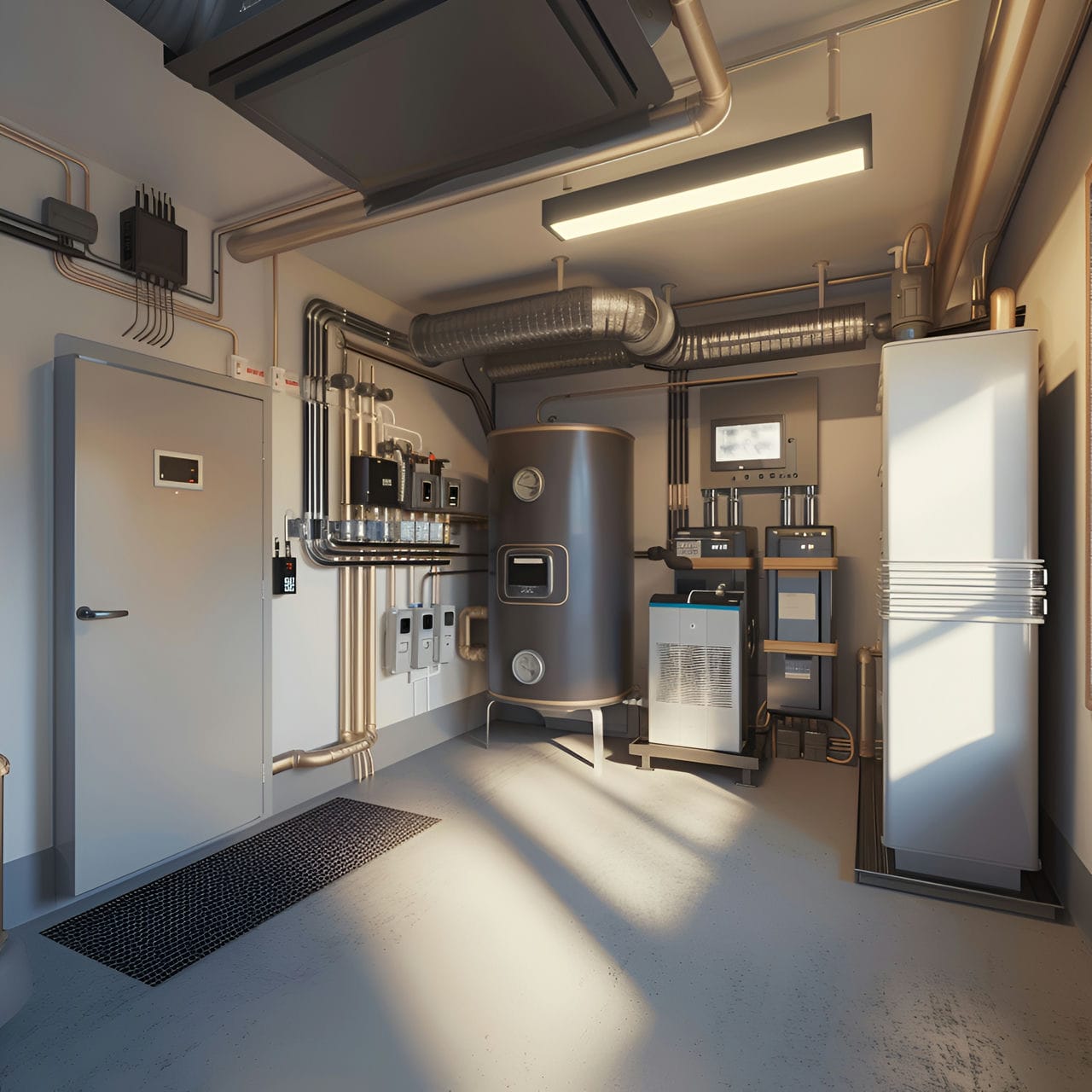
Grand residential boiler rooms minimally exceed approximately 160 square feet (15 square meters), frequently reaching 215 square feet (20 square meters) in elite luxury estates. Soaring ceilings reaching 10 feet (3 meters) become essential for built-in redundancy equipment, integrated home automation servers that control systems estate-wide, and specialty air filtration features. Appliance mechanics require extensive perimeter clearances for maintenance across significantly heavier commercial-grade equipment.
What is the use and purpose of a boiler room?
The use and purpose of a boiler room is to house boiler heating systems, enabling centralized operation, maintenance, and safety controls. Firstly, the boiler room houses the boiler and related heating equipment that provides hot water and heat to the building. This centralized mechanical room allows efficient operation and maintenance of the systems that keep occupants warm. Secondly, the boiler room contains safety equipment like water feeders, valves, pumps, fuel storage tanks, emissions controls, etc. This equipment regulates boiler functions, monitors performance, and prevents leaks, explosions, or carbon monoxide. Thirdly, the dedicated boiler room space separates noisy mechanical systems from living areas for comfort. Doors, insulation, and vibration dampeners reduce noise transfer to keep surrounding rooms quiet. Fourthly, the consolidated boiler room makes inspection and repairs more convenient with all equipment in one place. Technicians can easily access the central systems without intruding into other building areas. Lastly, boiler room design, construction materials, and ventilation are customized to contain and operate equipment safely. Fireproof construction, drainage, outdoor air intakes, and flue gas venting protect the rest of the structure.
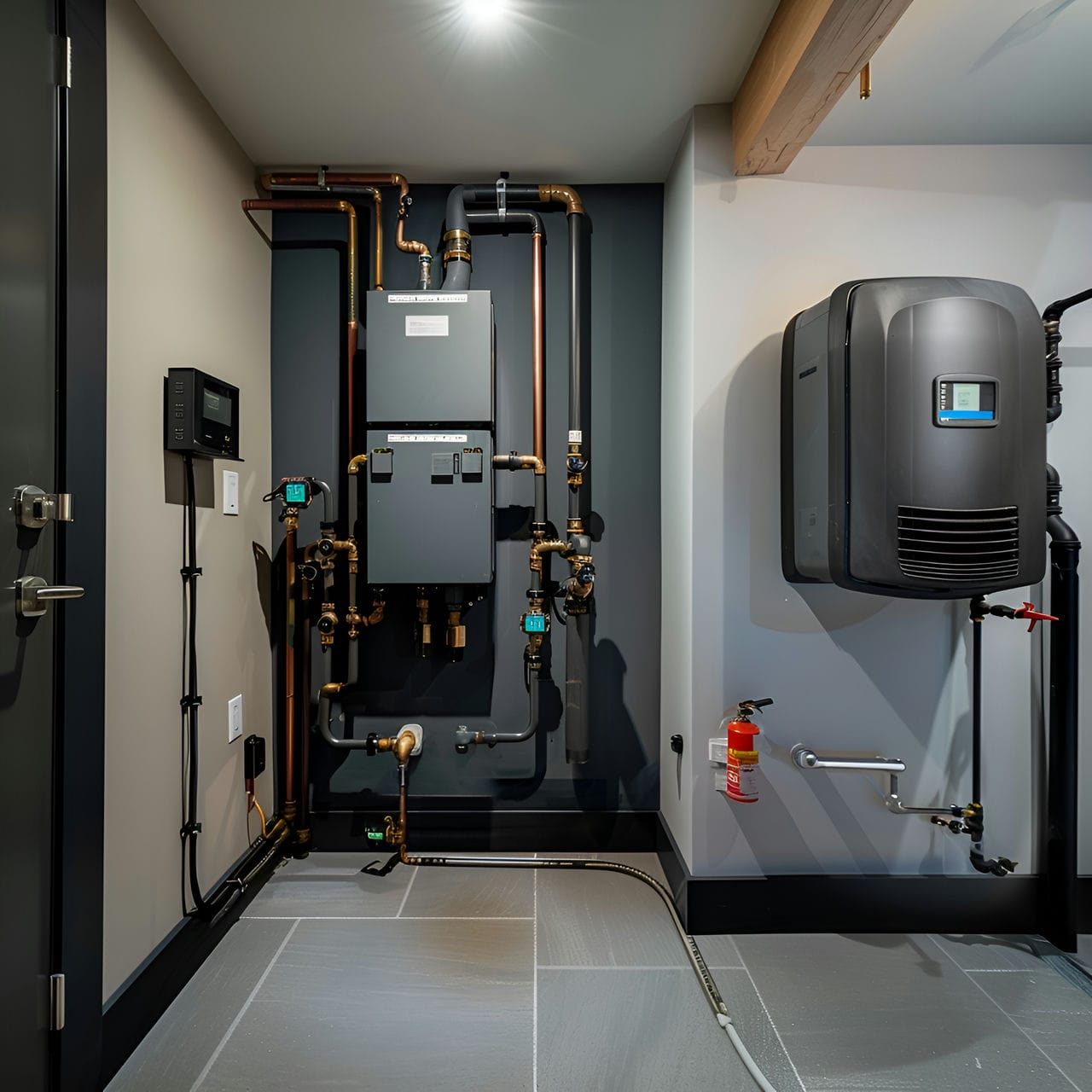
What is the typical shape of a boiler room?
The typical shape of a boiler room is a rectangular floor plan for space optimization and efficiently fitting equipment. Average residential boiler rooms position the longest wall spanning approximately 30 square feet (2.5 meters) to 50 square feet (4 meters) against the exterior foundation or buried underground. The narrow width ranges from approximately 20 square feet (1.5 meters) to 40 square feet (3 meters), accommodating essential heating systems, water tanks, and supplemental supplies in sequence. An entry door is located on one end for maintenance access or emergency drainage/replacement needs, with the opposing side hosting exhaust outputs and ventilation required by code spanning 1 foot (0.3 meters). Short edge dimension lengths maximize external infrastructure connections through concrete walls to gas, electric, and plumbing lines servicing the estate. Contemporary high-efficiency heating plants incorporate more advanced computer automation, allowing remote mobile oversight capabilities.
What furniture commonly equips a boiler room?
Listed below are the types of furniture commonly equip a boiler room:
- Utility Shelving: Utility shelving in a boiler room is essential for organizing tools and equipment. These furniture are made from metal or heavy-duty plastic, designed to withstand the room’s heat and humidity. They come in various sizes, accommodating everything from large equipment to small tools.
- Workbenches: Workbenches in a boiler room provide a sturdy surface for maintenance tasks. Often constructed from heavy-duty steel or wood, this furniture is designed to support significant weight and resist damage from tools and equipment.
- Tool cabinets: Tool cabinets in a boiler room are vital for storing and securing tools. Made from durable materials like steel, they resist damage and provide a safe storage solution. The furniture in a boiler room often has lockable drawers or compartments, ensuring that tools and equipment are kept secure and organized.
- Safety equipment storage: Safety equipment storage in a boiler room is crucial for quick access to safety gear. These furniture storage solutions, often in the form of wall-mounted racks or cabinets, hold items like fire extinguishers, first aid kits, and protective clothing.
- Filing cabinets: Filing cabinets in a boiler room are used for organizing documents such as manuals, maintenance records, and safety protocols. Constructed from metal or fire-resistant materials, this furniture safeguards important paperwork.
- Sturdy chairs or stools: Sturdy chairs or stools in a boiler room accommodate personnel during breaks or while monitoring equipment. This furniture is often made from steel or reinforced plastic, designed to withstand industrial conditions.
- Portable tool carts: Portable tool carts in a boiler room facilitate the transportation of tools and equipment around the room. Constructed from heavy-duty materials, this furniture features wheels for mobility and multiple shelves or compartments for organization.
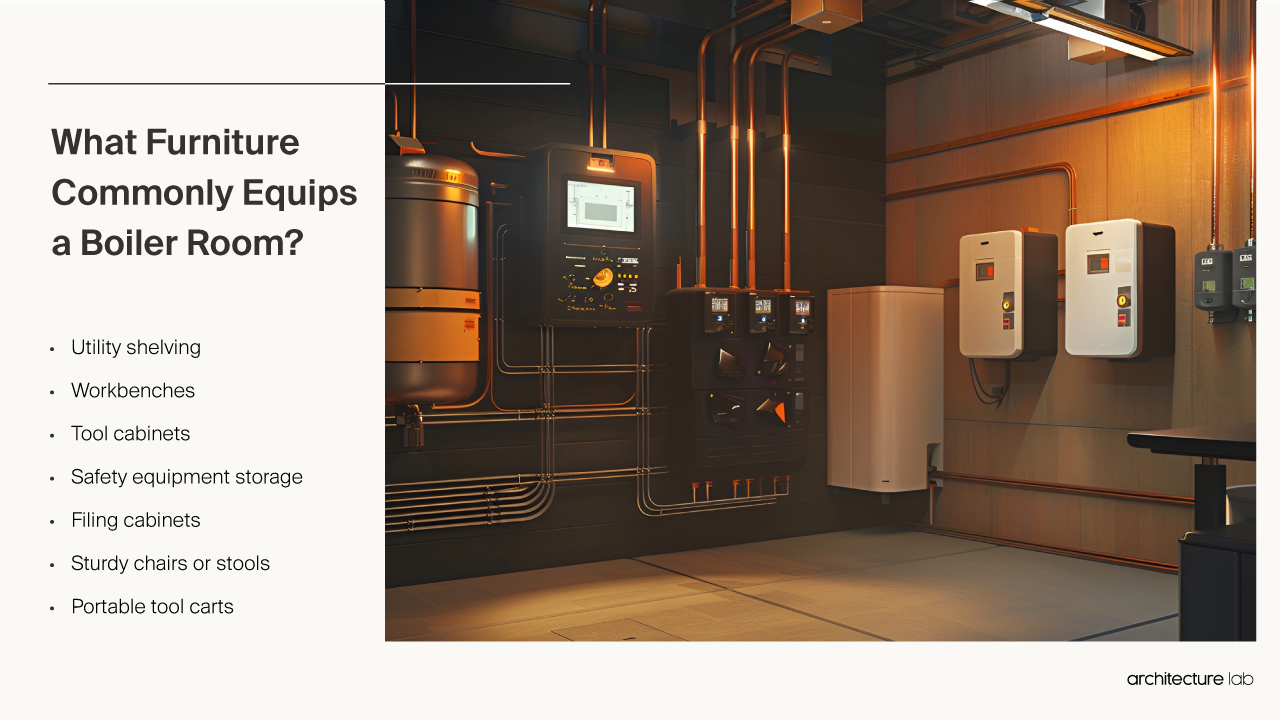
What is the normal ceiling height of a boiler room?
The normal ceiling height of a boiler room is approximately 30 square feet (2.5 square meters) to 35 square feet (3 square meters). This enables typical upright boiler tanks to fit while allowing 3 feet (1 meter) clearance above appliance tops for service access as mandated. Tankless designs continue gaining popularity in modern homes, using less physical footprint. Contemporary updates allow taller heights of up to approximately 35 square feet (3 square meters) in renovated spaces. Anything lower risks proper inspector codes, while excessive heights cultivate unusable, difficult-to-heat vacant air mass.
What colors are boiler rooms usually painted?
Listed below are the colors usually used in boiler rooms painted:
- Gray: Boiler rooms commonly utilize gray, which is practical for industrial settings. Gray ranges from light to dark shades, chosen for its ability to mask dirt and wear. This color is versatile, easily integrating with machinery and pipework.
- White: White is used in boiler rooms for its clean, crisp appearance. It helps illuminate the space, making it easier to spot maintenance issues. White paint colors often have a gloss finish for easy cleaning and durability. It also serves as a contrast to the typically darker machinery.
- Blue: Blue colors are selected in boiler rooms for their calming effect. Shades like navy or sky blue are popular. It is also used for color-coding purposes, distinguishing different areas or pipe systems for safety and organization.
- Green: Green is chosen for boiler rooms, particularly in darker shades like forest or hunter green. This color is used for its association with safety and calmness. Green can also denote specific areas related to environmental systems within the boiler room.
- Yellow: Yellow is used in boiler rooms for safety and warning signs. Bright colors like lemon or mustard are visible even in low light, ideal for marking hazardous areas or essential instructions.
- Red: Red is commonly used in boiler rooms for its high visibility and association with danger or caution. This color is often applied to alert workers to high-risk areas, emergency shut-off switches, or fire safety equipment.
- Beige: Beige is occasionally found in boiler rooms, mainly in administrative or less industrial areas. This color provides a neutral and less industrial feel, often used in office spaces within the boiler room.
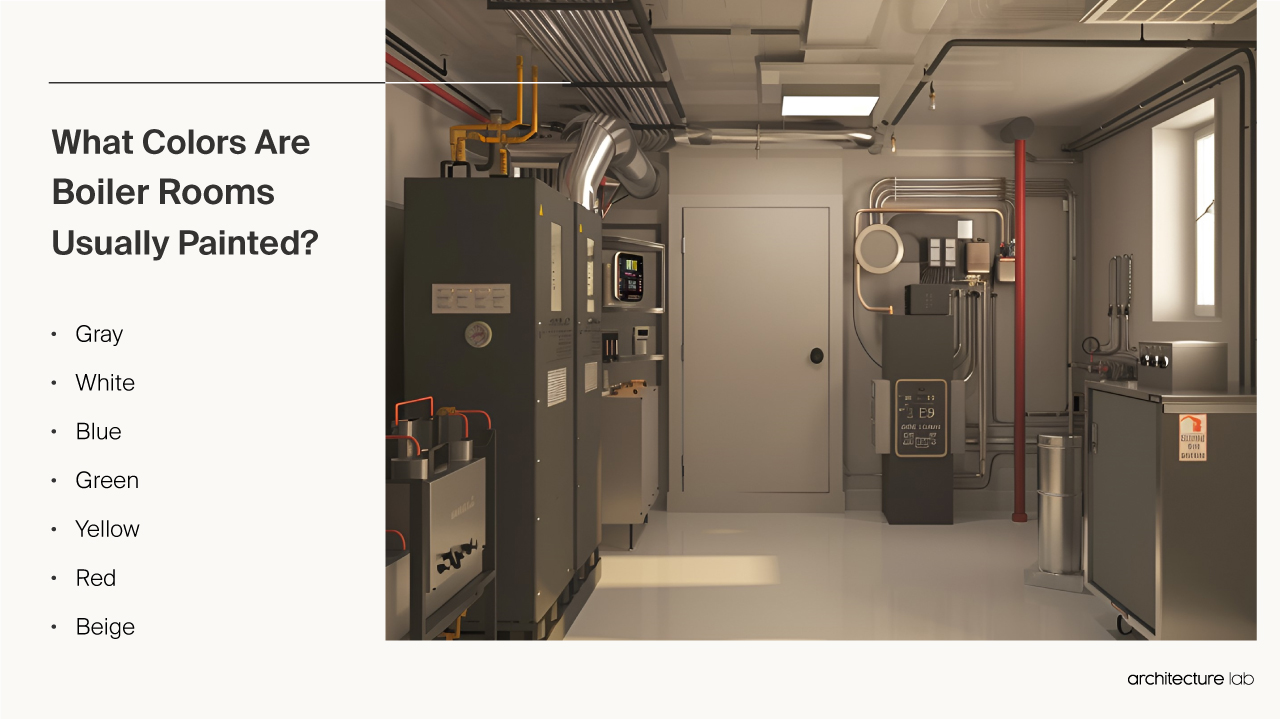
What makes the boiler room functional?
The boiler room is functional with fire protection and ventilation, contains well-maintained mechanical equipment with adequate clearances, and is regularly inspected and serviced by professionals. Firstly, the primary function of a boiler room is to house the boiler, furnace, HVAC, or other mechanical equipment that produces hot water and controls the heating and cooling systems in a home. Secondly, for a boiler room to function correctly, it needs to meet specific building codes and regulations related to safety and accessibility. The room doors should open outwards, be self-closing, and be rated. The walls and ceilings should be fully enclosed with no gaps or windows. Ventilation systems need to be in place to prevent overheating. Thirdly, regular inspections and maintenance are critical to keep the boiler and boiler room functioning over time. An annual professional servicing of the boiler can identify and resolve any issues early before they become dangerous or costly problems. Lastly, routine checks for leaks, odd sounds or smells, corrosion, and proper airflow can prevent emergency repairs. Keeping the boiler room clean, uncluttered, and free of combustible materials also reduces safety hazards.
How is energy efficiency achieved in a boiler room?
Energy efficiency is achieved in the boiler room through insulating pipes and the boiler, upgrading to a high-efficiency condensing boiler, incorporating heat recovery systems, using on-demand water heating, and adding solar thermal technology. Firstly, installing proper insulation around the boiler and any heated water pipes is crucial to prevent heat loss and improve efficiency. Fiberglass, foam, or other high-R-value insulation materials reduce wasted thermal energy. Secondly, upgrading to a high-efficiency condensing boiler that recycles heat can provide over 90% fuel utilization efficiency compared to 80% for conventional boilers. Condensing boilers extract more heat from exhaust gases, wasting less energy. Integrating smart boiler controls further optimizes performance. Thirdly, heat recovery systems preheat inlet water by capturing waste heat from the boiler exhaust. Fourthly, switching to an on-demand or tankless water heating system only heats water when needed, cutting standby losses associated with storage tanks. This is especially useful if hot water needs fluctuate significantly. Lastly, installing solar thermal panels allows utilizing renewable energy for water heating needs, reducing boiler runtime and fossil fuel usage. Solar thermal systems work well in greenhouse environments.
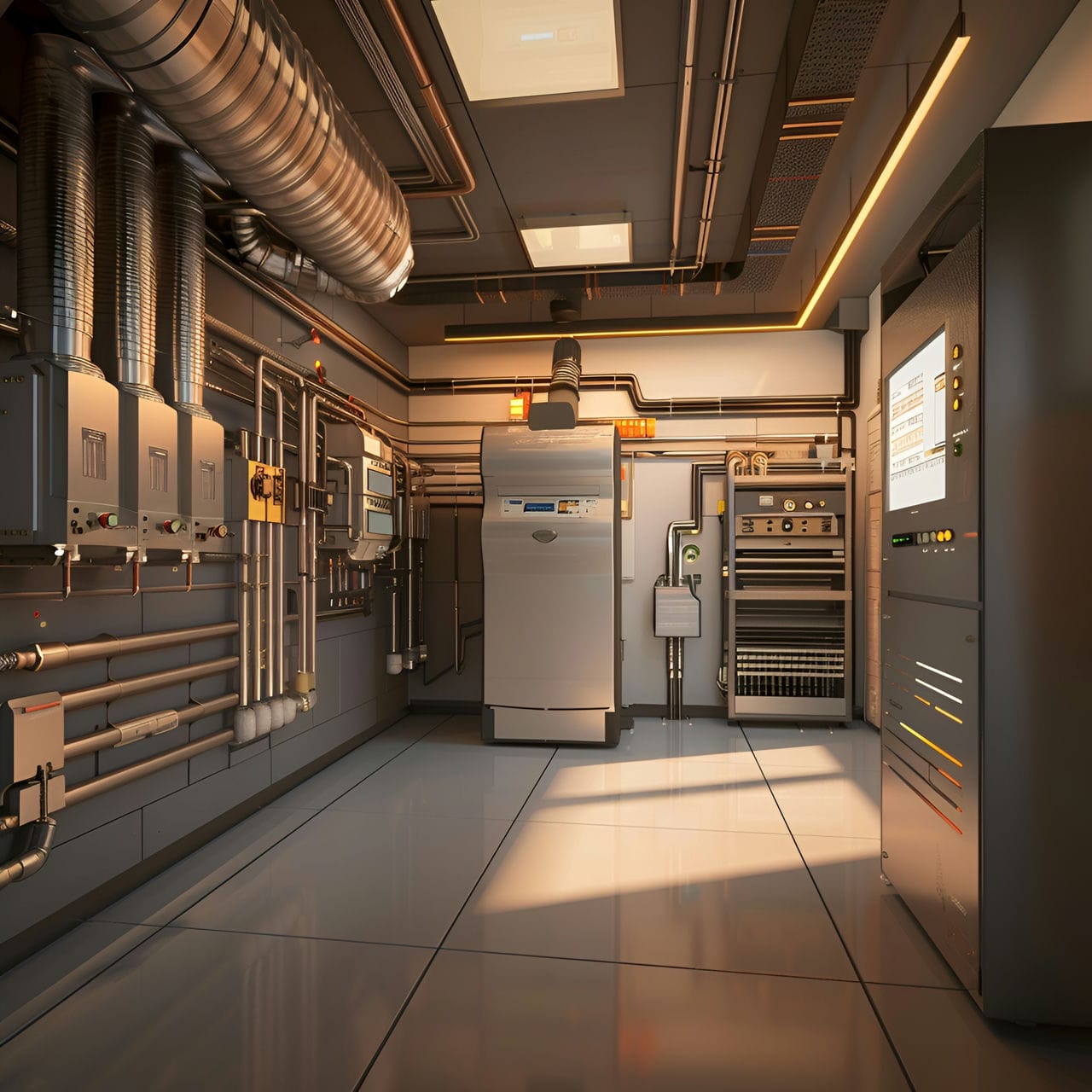
How much does it typically cost to renovate a boiler room?
The average cost to renovate an existing residential boiler room ranging from approximately 35 square feet (3 square meters) to 55 square feet (5 square meters) falls between $4,000 (€3,600, £3,000) to $10,000 (€9,000, £7,600). Replacing aging tank water heaters or boiler systems with more high-efficiency ENERGY STAR models would cost closer to $4,000 (€3,600, £3,000). Comprehensive heating system overhauls upgrading to tankless water supplies plus integrated smart home automation technology drive prices toward $10,000 (€9,000, £7,600). Any additional insulation, HVAC ventilation repairs, or exhaust fan ducting would range from $1,500 (€1,350, £1,150) to $3,000 (€2,700, £2,300). For contemporary systems with eco-friendly geothermal heat pumps, WiFi-enabled touchscreen climate controls, and real-time usage notifications, expect total transformation budgets of up to $25,000 (€22,500, £18,900). Typical boiler room functional replaces averaging $4,000 (€3,600, £3,000) to $7,500 (€6,750, £5,700) update essential heating and water equipment. Extensively “smart” renovations or large-scale sq. ft additions would exceed $15,000 (€13,500, £11,400) given their structural footprints and technology integrations.
What factors affect the boiler room renovation?
Listed below are the factors that affect the boiler room renovation:
- Size and layout: The size and layout of a boiler room are crucial factors in its renovation. Larger boiler rooms allow for more equipment and storage space, while smaller ones need efficient space utilization. Structural considerations, such as the placement of boilers and piping, affect the renovation’s extent.
- Ventilation and safety systems: These are critical in boiler room renovations. Adequate ventilation ensures the safe operation of boilers and prevents the buildup of harmful gases. Upgrading safety systems, including fire suppression and alarm systems, is often required to comply with regulations.
- Machinery and equipment: The type and condition of machinery and equipment in a boiler room influence the renovation. Upgrading or replacing boilers and other equipment can improve efficiency and safety. The choice of equipment affects space requirements, energy efficiency, and operational costs.
- Energy efficiency: Energy efficiency is a key factor in boiler room renovations. Improving insulation, upgrading boilers to more efficient models, and installing energy management systems can reduce operating costs. These changes affect the environmental footprint and have long-term financial benefits.
- Compliance with regulations: Compliance with local building codes and safety regulations is essential in boiler room renovations. Regulations dictate standards for boiler operation, emissions, and safety. Ensuring compliance may require significant modifications, impacting the renovation’s scope and cost.
- Accessibility and maintenance needs: Accessibility and maintenance needs impact boiler room renovations. Easy access to boilers and related equipment is necessary for regular maintenance and emergency repairs. Renovation designs must consider the placement of equipment and the inclusion of access paths.
- Budget and financial constraints: The budget and financial constraints significantly shape boiler room renovations. A larger budget allows for comprehensive upgrades and the use of higher-quality materials. Financial limitations might necessitate focusing on critical aspects, such as safety upgrades or essential repairs.
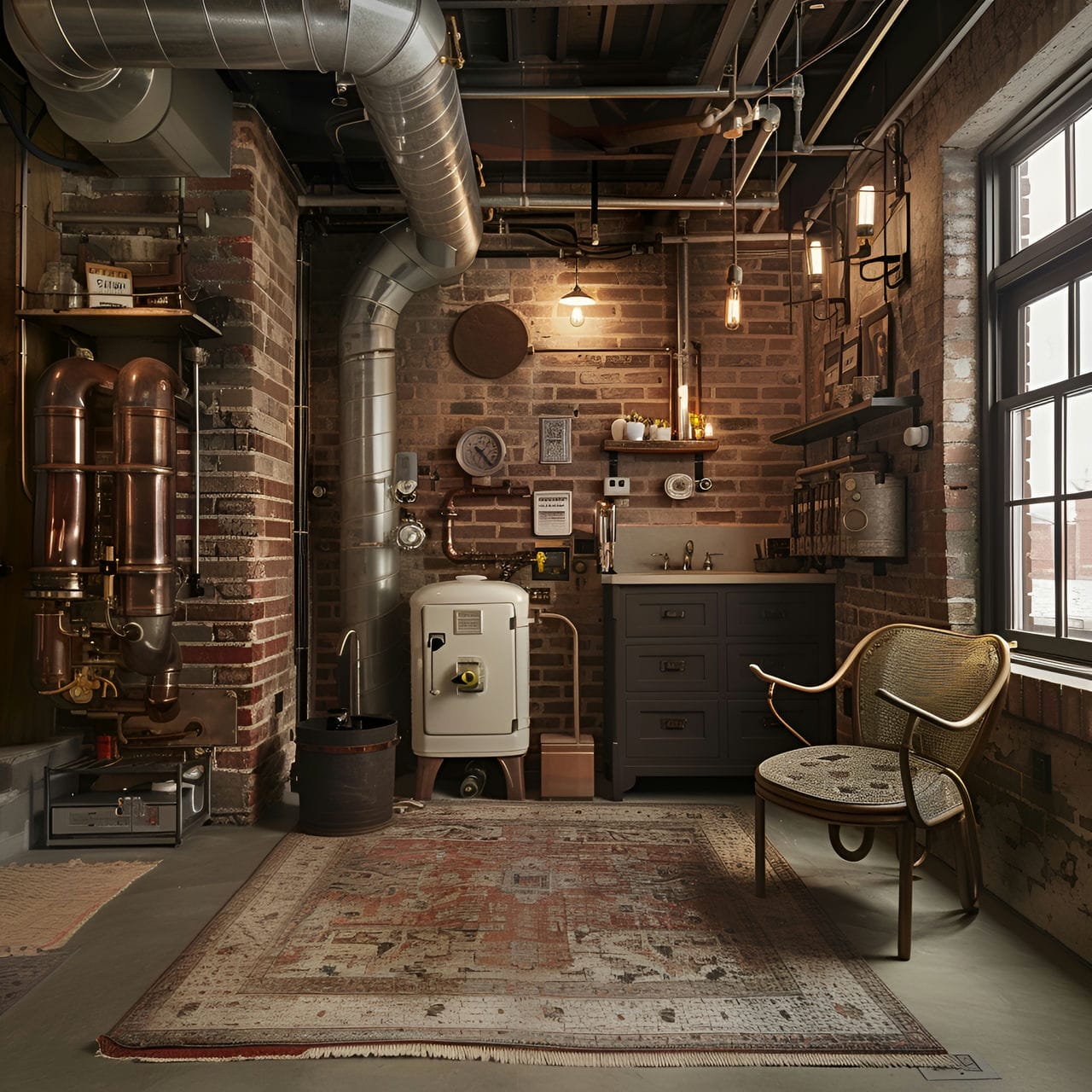
Is an architect required to renovate a boiler room?
No, an architect is not strictly required to renovate a boiler room, but it is highly advised to hire one. The involvement of an architect in remodeling a boiler room brings several key advantages. Architects possess specialized knowledge in designing spaces that are efficient, safe, and compliant with regulatory standards. They can effectively plan the layout to optimize space utilization while ensuring easy access for maintenance and emergencies. Architects are also adept at selecting appropriate materials to withstand the harsh conditions in boiler rooms, such as high temperatures and humidity. They understand the complexities of building codes and safety regulations, which is crucial in avoiding potential legal issues. Their expertise in managing construction projects can also be invaluable in coordinating with contractors, supervising the work, and keeping the renovation on schedule and within budget.
How can an architect help you upgrade a boiler room?
Listed below are the ways that an architect can help an owner upgrade a boiler room:
- Space optimization: An architect can optimize the space in a boiler room, enhancing its functionality and safety. They assess the existing layout and design a more efficient arrangement, ensuring easy access to boilers and equipment. Space optimization involves strategic placement of machinery and storage, creating clear pathways for maintenance and emergency access.
- Ventilation and safety: Enhancing ventilation and safety in a boiler room is a key area where an architect can contribute. They design ventilation systems that effectively remove heat and gases, essential for the safe operation of boilers. Safety enhancements may include fire-resistant materials and emergency exits.
- Material selection: Selecting appropriate materials for a boiler room renovation is crucial, and an architect can provide expert guidance. They recommend materials that withstand high temperatures and humidity, such as heat-resistant paints and insulating materials.
- Energy efficiency: Improving energy efficiency in a boiler room is an area where an architect can contribute significantly. They can design systems for heat recovery, insulation improvements, and efficient boiler operation.
- Compliance with regulations: Ensuring compliance with regulations is a complex aspect of boiler room renovations, and an architect can manage this process. They have expertise in local building codes, safety regulations, and environmental standards.
- Equipment and technology integration: An architect can facilitate the integration of new equipment and technology in a boiler room. This includes planning for new boilers, control systems, and monitoring equipment. The architect ensures that these upgrades fit within the existing space and are accessible for maintenance.
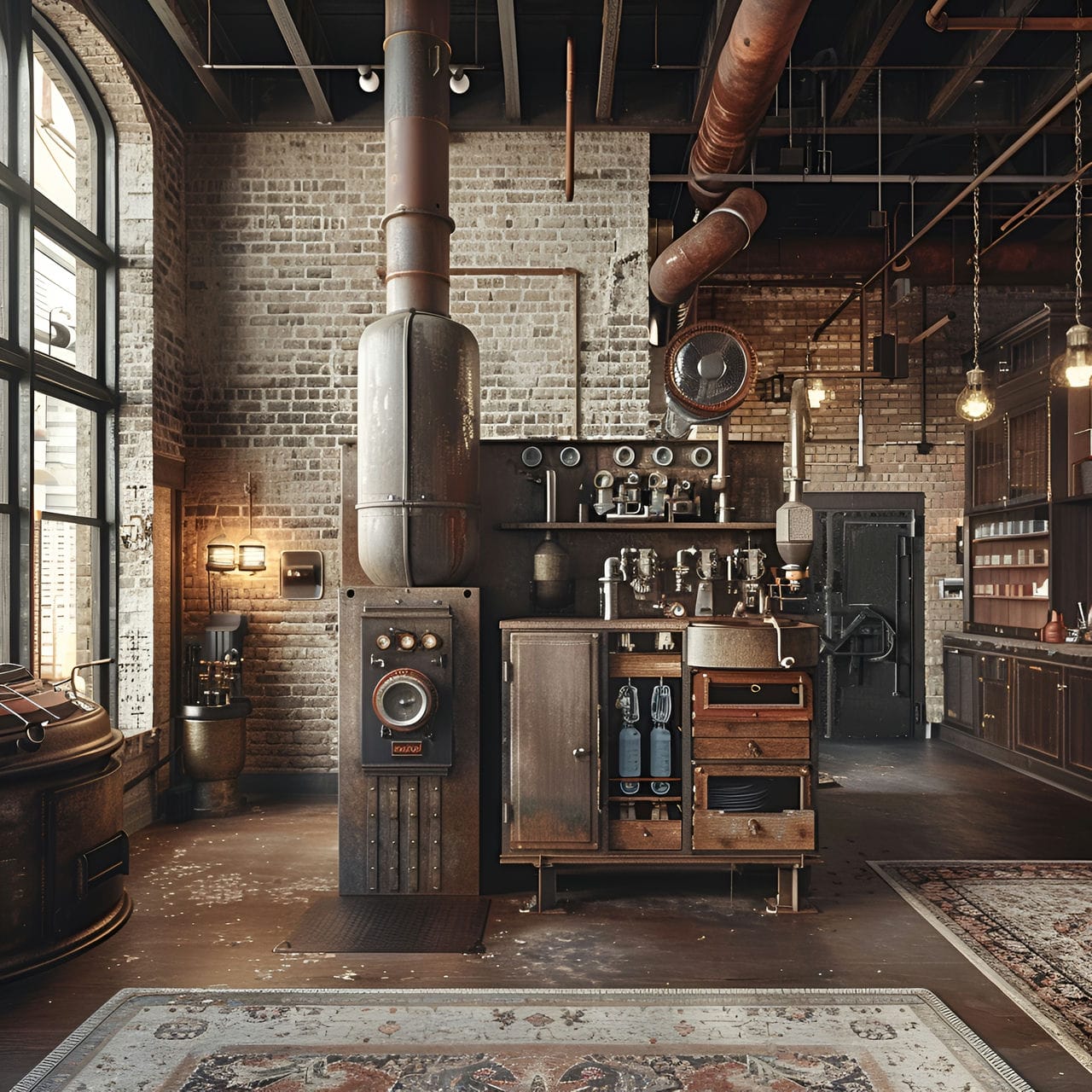
How much does it cost to hire an architect to renovate a boiler room?
The average cost to hire an architect to design a residential boiler room renovation ranges from $800 (€720, £600) to $1,500 (€1,350, £1,150) based on the scope of work. Most architects charge between $100 (€90, £75) to $150 (€135, £115) per hour. Evaluating an existing 35 square foot (3 square meters) system layout with recommended upgraded heating and hot water equipment options may take 4-6 hours for fees of approximately $800 (€720, £600). Specifying commercial elements like ventilation protocols or emergency floor drainage for a 55 square foot (5 square meters) boiler room remodel requires closer to 8-12 architectural hours, averaging approximately $1,200 (€1,080, £915). Engineers tailoring high-efficiency contemporary plants involving tankless water supplies, smart home automation technology controls, and eco-friendly geothermal heat pumps often advise $1,500+ (€1,350+, £1,150+). Modest boiler room equipment overhauls with some layout optimizations run $800 (€720, £600) to $1,200 (€1,080, £915) including professional guidance. More extensive structural renovations or equipment additions to amplify output or redundancy capacity would increase prices closer to $1,500 (€1,350, £1,150) for advisor oversight across disciplinarians. Given limited square footage, most boiler room architectural needs cost $100/ per hour (€90/ per hour, £75/ per hour) unless expanding scale or integrating intricate sequence modifications.
Is it worth it to hire an architect to upgrade a boiler room?
Yes, hiring an architect to upgrade a boiler room can be a valuable investment. Boiler rooms are complex spaces requiring specialized knowledge to ensure safety, efficiency, and compliance with regulatory standards. An architect brings expertise in designing industrial spaces, focusing on optimal layout, ventilation, and integrating complex systems. They can effectively plan to include modern, energy-efficient boilers and related equipment while ensuring the space remains accessible for maintenance and safe for operation. Their ability to oversee the project, from design through completion, and coordinate with various contractors can also streamline the process, potentially saving time and reducing costs.
How long is needed to redecorate a boiler room?
Redecorating a boiler room typically takes 3 to 8 weeks. Firstly, the size of the boiler room is a determining factor in the project timeline. Larger spaces with more equipment may require a more extended period for a thorough redecoration, especially if complex machinery needs to be moved or disconnected. Secondly, the scope of the redecoration impacts the duration. Simple cosmetic updates, like repainting or adding storage solutions, can be accomplished relatively quickly. Thirdly, compliance with safety standards and regulations is a pivotal factor. Time spent ensuring that all upgrades meet industry standards and local building codes can extend the project duration, especially if inspections or permits are involved. Lastly, unforeseen challenges or complications during the project, such as discovering structural issues or encountering unexpected delays in supply chains, can further delay completion.
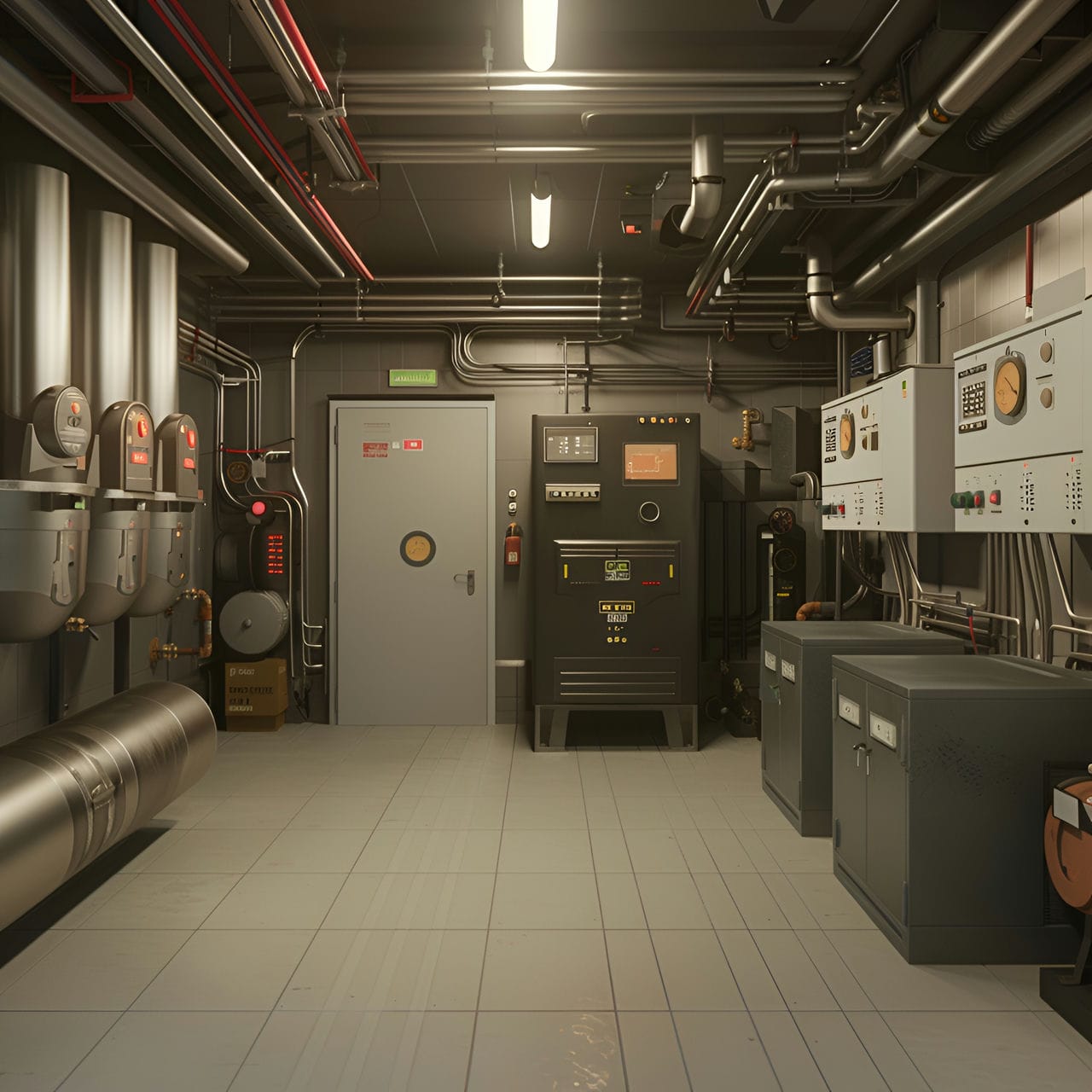
What are the struggles of the homeowner to redecorate a boiler room?
Listed below are the struggles of the homeowner to redecorate a boiler room:
- Adhering to safety standards: Homeowners often need help ensuring that the redecoration of a boiler room adheres to strict safety standards. This involves understanding and complying with boiler operation, ventilation, and fire safety regulations.
- Balancing functionality and aesthetics: Balancing functionality with aesthetics in a boiler room is a significant challenge. The primary focus is on the practical operation of the boiler and related systems, which can limit decorative choices.
- Selecting appropriate materials: Choosing materials that can withstand the harsh conditions of a boiler room is difficult. Materials must be heat-resistant, durable, and suitable for an environment that may experience high temperatures and humidity.
- Space optimization: Optimizing limited space in a boiler room poses a challenge. Homeowners must efficiently arrange the boiler, storage, and work areas in cramped quarters. This requires careful planning to ensure easy access for maintenance and emergencies.
- Managing ventilation and air quality: Ensuring proper ventilation and maintaining air quality is a struggle in boiler room redecoration. Homeowners must navigate complex ventilation requirements and often need professional assistance to implement practical solutions.
- Navigating technical complexities: Dealing with the technical aspects of a boiler room, such as understanding the boiler mechanics and energy systems, is challenging for many homeowners. These complexities often require specialized knowledge, making it difficult for homeowners to decide about upgrades and changes.


